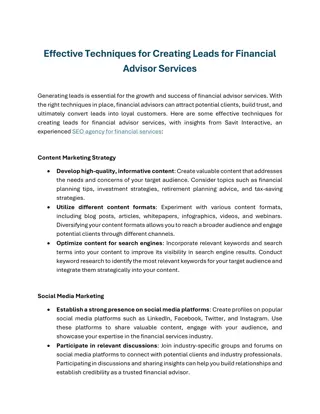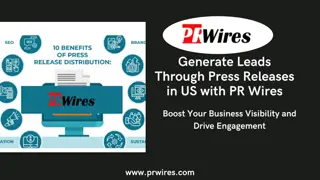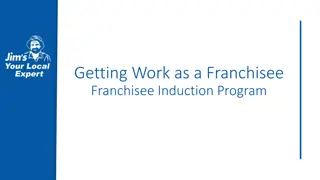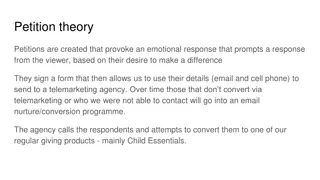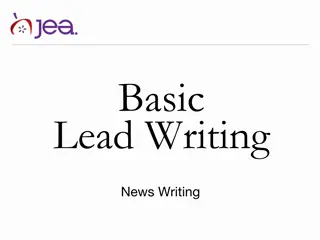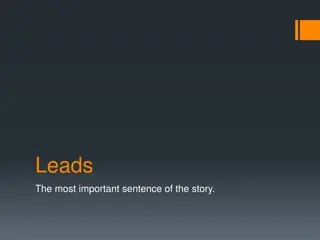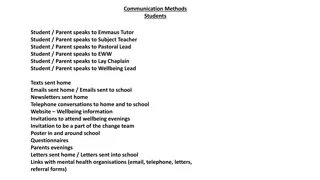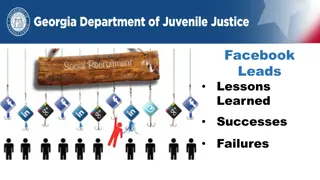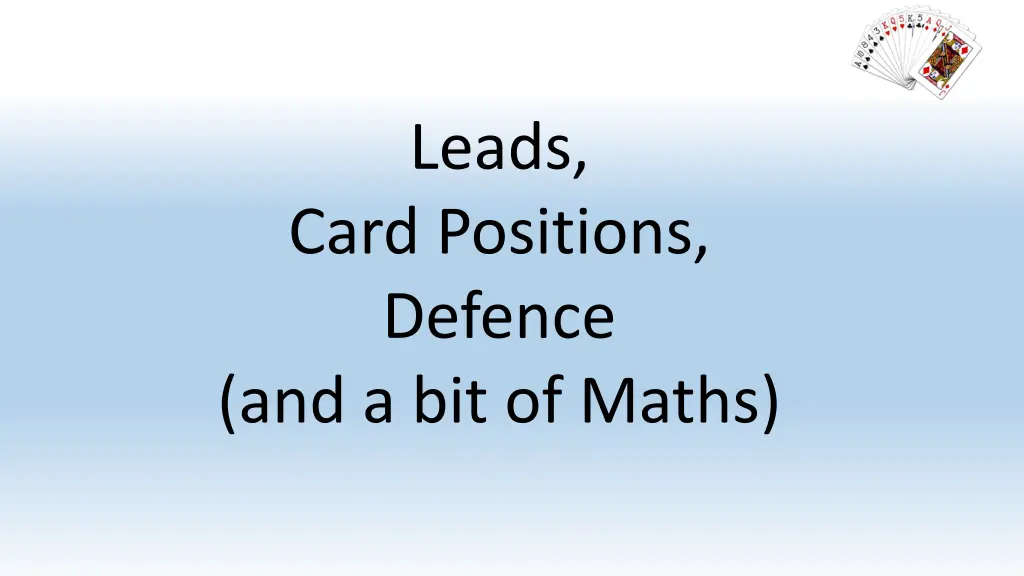
Understanding Bridge Card Probabilities and Strategies
Discover the mathematical insights behind Bridge card distributions, probabilities, and strategic plays. Explore the probabilities of different hand patterns, the vast number of possible deals in Bridge, and strategies like the 8-Ever, 9-Never rule. Enhance your understanding of Bridge tactics from a mathematical perspective.
Download Presentation

Please find below an Image/Link to download the presentation.
The content on the website is provided AS IS for your information and personal use only. It may not be sold, licensed, or shared on other websites without obtaining consent from the author. If you encounter any issues during the download, it is possible that the publisher has removed the file from their server.
You are allowed to download the files provided on this website for personal or commercial use, subject to the condition that they are used lawfully. All files are the property of their respective owners.
The content on the website is provided AS IS for your information and personal use only. It may not be sold, licensed, or shared on other websites without obtaining consent from the author.
E N D
Presentation Transcript
Leads, Card Positions, Defence (and a bit of Maths)
Some Maths The game of Bridge relies heavily on, not only the skill of bidding and playing, but also thinking about card distribution, possibilities of hand holdings and probabilities. It is also about playing the odds in your favour. A lot of mathematical work has been done to explain some of these bridge situations. I don t want to go deep into the mathematics behind these situations, but it is interesting to look a few conclusions and it may give you a better understanding what is happening, and why, when you play. So let s have a look at a few: This is the formula for working out the probability of card distribution if you can see the dummy. Lets look at something a bit simpler and more useful!
Some Maths This table shows the hand pattern distribution in probability order. The full table is not shown, only the top and bottom. Look at the probability of being dealt a 13-0-0-0 hand! You can see that a 4-4-3-2 hand is most common (22%) and it is not until you get to 6-3-2-2 does the probability drop somewhat. Interesting that the perfect balanced hand, 4-3-3-3, only has a probability of 11%. Now you can see why the NT bid occurs most often and therefore why it is important to learn the NT bid and responses. This table shows the probability of being dealt a certain type of hand. You can see that Balanced will occur 48% of the time.
Some Maths Interesting fact: there are 53,644,737,765,488,792,839,237,440,000 (53.6 x 1027) different deals possible. "How large an area would you need to spread all possible bridge deals if each deal would occupy only one square millimeter?". The answer is: an area more than a hundred million times the surface area of Earth. This table shows the probability of the number of Losing tricks in a hand. You can see that the highest probability is 7 LTC, hence why, when we do the losing trick count, we put the opener with 7 losing tricks, and even if we are wrong, the next highest probabilities are 6 or 8.
Some Maths And finally, lets look at the 8 Ever, 9 Never strategy. This little ditty says that if you are missing the Queen and you have 8 cards in a suit between you and the dummy, you should Finesse. If you have 9 cards you should play for the drop. I am not going to explain the working out (go to How to Calculate Bridge Suit Split Combinatorics/Probability (durangobill.com) if you want to see all that), but the conclusions are: First the 8 cards. The calculated success rate of playing a Finesse is 0.5283 (52% probability it will work) The calculated success rate of playing for the drop is 0.3474 (35% probability it will work) Therefore the Finesse is the winner. Now 9 cards. The calculated success rate of playing a Finesse is 0.5622 (56% probability it will work) The calculated success rate of playing for the drop is 0.5792 (58% probability it will work) Therefore playing for the drop is the winner (just, but that is what playing the odds is all about). The ditty seems to hold up! And you thought Bridge was a game of Skill!!!!
Leads The opening lead can make or break a contract, especially when playing against a NT contract. It is one of the most important decision the defence will make during the play. Never forget you are playing with a partner. It pays to consider what things may look like from partner s point of view. You cannot defend properly unless you remember the bidding. You cannot defend properly unless you watch the cards, particularly the little fellows. You cannot defend properly unless you count. Keep one goal in mind: DEFEATING THE CONTRACT. The figure to focus on during the defence is the number of tricks you need at any given moment to defeat the contract. Take your time to decide what card to lead. There are basically two decisions to be made: What suit to lead What card in that suit to lead. (NOTE: in the following examples, a 10 is counted as a High Card)
Leads What SUIT to lead? Lead a suit bid by your partner. If he has overcalled, he should be expecting you to lead that suit and therefore he should have reasonable suit quality. The other reason for leading this suit is that you cannot lose the post mortem if things go wrong! If it was wrong to lead his suit, then it was his fault for bidding it . . . . The only justifications for notleading Partner s bid suit are: A dangerous holding in the suit such as A-x-x An especially inviting other lead, like a singleton or solid suit. When a trump lead seems correct. Basic Leads against a NT contract. 1. 2. See above! Lead the 4th highest from an honour of your longest and strongest suit except: a. If you are very weak. In this case try to lead your partner s suit even if he hasn t bid one! b. Your Opponents have bid your preferred suit. Try to lead an unbid suit. c. Your have a 4 card suit headed by a solitary King or Queen.
Leads You are very weak, try to lead partners suit even if he hasn't bid. The object of leading your longest suit is to try to establish winners later on in the game play. If you are very weak, this is very unlikely to happen. A better lead would be to play to your partners strength. If you are weak, he is probably strong and you can help to establish his winners for later. To achieve this lead you really do need to have listened and understood the Auction (as you should anyway)! For example: Your hand The Auction North South 1 2 3NT End What do you lead as West after this Auction? 2NT If you blindly follow the 4th highest from the longest suit, there is little hope of establishing tricks in Spades and, even if you do establish the suit, you have little chance of getting the lead back. So what can you assess from the Auction? I have Spades, South has Hearts and North has Clubs, so my partner s likely suit is Diamonds. Lead the Jack of Diamonds (top of touching honours).
Leads Leading the Unbid Suit. This is perhaps the most important lead available after you leading your Partners suit, especially in a no-trump contract. When the opponents have bid three suits on the way to a contract, they are most likely to be weakest in the unbid suit. Always contemplate leading the unbid suit, however many cards you have in it. Your hand The Auction North 2 3 End South 1 2 3NT What do you lead as West after this Auction? There is something to be said for leading a spade since Q will not give much away, but the auction has suggested that South has a five-card suit in Spades. Because South has opened 1 Spade and rebid Diamonds. A rebid of a different suit tells partner that I have 5 of original suit and 4 of new suit. So South has 5 Spades and 4 Diamonds. How do you know that? Much better is to lead the unbid suit, Hearts. Both North and South would have shown four Hearts if they had them; and if they only have three each, that leaves your partner with five. The Jack of Hearts, top of a doubleton, attacks declarer s weakness.
Leads A couple of other tips 1. Think about Stayman. Why didn t they use it? Compare the auctions 1NT 3NT and 1NT 2 2 3NT. Responding to 1NT you tend to use Stayman when you hold a four-card major (as in the second Auction). In the first auction, responder is unlikely to have four hearts or four spades otherwise he would have used Stayman. In this situation, if you have a choice between two four-card suits, one of which is a major, then lead the major. In the second auction what do you know about the layout of the oppositions hands? You can surmise that: Opener has 4+ Hearts, he responded 2 to the Stayman bid Responder has 4+ Spades (he bid Stayman so must have a 4 card Major) and he did not support the 2 response or Pass (weak take-out), and because he bid NT he must have Spades.
Leads A couple of other tips 2. Do you want an Active or Passive lead? Active means trying to establish tricks and involve taking risks to establish quick tricks, aiming for ruffs an honour doubleton lead fall into this category. Passive leads involve low risks and letting declarer go wrong - avoid leading from (non-touching) honour combinations, prefer solid suits or trump leads. Consider the following Auction: This Auction suggests the partnership has about 25 HCP and will be tight on the contract Because Declarer opened 1NT (12HCP) and Responder bid Stayman (11HCP) then bid to the 3 level (+2 HCP) and Opener raised to Game. Declarer Responder 1NT 2 2 4 How do you know that? 3 End In this case, be passive and try not to give away a trick on your lead. Now consider this Auction: This Auction suggests that the opponents will have at least 28 points. Because Declarer opened (12HCP), Responder jump bid in new suit (16+HCP), and you know something else .. What do you know? Declarer Responder 1 3 3 4 Because Declarer rebid Spades, and did not support partners Heart bid, he probably has 6+Spades How do you know that? You expect their contract to make easily, so you will need a bit of luck to defeat it. You need an Active lead.
Leads Opening Leads to Avoid Don t lead an Ace unless you hold the King. An ace s job is to kill a king but, if you lead it, then your opponents can simply play low. However, if you hold the king as well, then the lead of an ace is one of the best you can make. If you lead an Honour, it promises the one below it. Don t Lead away from a King in a suit contract. A lead away from any high honour against a suit contract is very risky, but leading away from a king is especially dangerous, except if your partner has bid that suit. Kings should kill high cards and in a suit contract, where only two rounds of a suit are likely to stand up before ruffing, you need your king. If you lead away from it and allow declarer to make his queen on the first round and his ace on the second, your king will have been wasted. Don t Lead a singleton Trump. Because your partner will often hold three or four trumps and your lead will ruin holdings such as Q-x-x and J-x-x-x. Only make such a lead if you are trying to attack dummy s trumps: a singleton trump is more of an active lead than a passive one
Leads Opening Leads to Avoid Don t leading away from an ace against a suit contract (never do that!). Because you risk making the opponents King or Queen! You are East, partner leads 4 , what do you play? You know the lead is probably from an honour, so partner probably has the Jack, therefore you should play the 10 as the Ace is most probably Because he led a low card showing he has an Honour card and not away from the A , you can see the Dummy, How do you know that? in South s hand. If you had played the King, you would have lost 2 tricks, not 1 !!
Leads We have discussed which suit to lead and also touched on some advice about the kind of cards to consider. Now we will look closer at the choice of card to lead. 4th highest from an Honour (but no Honour sequence) The word Honour is important and tends to be forgotten. It is important because your partner will be expecting an honour if you lead the 4th highest card (especially against NT contract). It is the standard lead in a suit contract if you choose to lead from a long suit, e.g. J 9 8 4 2 3rd highest from 3 to an Honour. Not such a common lead, but it occurs most frequently when leading the unbid suit or your partner s suit. e.g. Q 9 4 (Low Like) Top of a Doubleton. If you choose to make a lead from a doubleton it is important to play the highest card first. It gives a message to your partner because if he sees you play high-low, then he will know you have just two cards. This is a very risky lead (especially an honour doubleton), but if it is an unbid suit you will often find success, or, of course, if it is your partner s suit.
Leads A Side Note a rule! Lead low from a single honour lead high with no honour. (Low Like/High Hate) Let us take a look at a couple of examples: Example 1 Example 2 South contract 4 You are East What would you play? What would you play? Partner (W) plays 3 of the suit and Dummy plays the 2. Partner (W) plays 8 of the suit and Dummy plays the 2. If your partner leads the three of clubs, he is promising an honour; you can see the ace, king, jack and ten, so you know that he has the queen! If your partner lead the eight, now you would know that he did not hold the queen hence you would play the king. Therefore you know that your ten will win the first trick.
Leads And finally! Leading Honour cards. When you have a sequence of honour cards you should always try to lead the top honour When you have 3 consecutive cards starting with an honour, you should lead the top one for all contracts. When you have 2 consecutive cards starting with an honour, you should lead the top one against a suit contract only. If you have a Broken Sequence where you have 2 touching high cards and one more just below, such as K-Q-10, or Q-J-10, you should lead the top honour against a NT contract. If you have 3 high cards with the lower two touching (Interior Sequence), such as K-J-10-5-4 lead the higher of the touching sequence (but remember the golden rule, never lead away from the Ace in a suit contract, so A-J-10-4-3 lead the Ace!).
Leads So, what would you lead with these cards? When you hold three high cards with the lower two touching, then you should lead the higher of the touching cards. suit contract. A broken sequence such as K-Q-10 or Q-J-9 where you have two touching high cards and one more just below. With these holdings you should lead high because you hope to be able to capture the missing honour in declarer's A broken sequence such as K-Q-10 or Q-J-9 where you have two touching high cards and one more just below. With these holdings you should lead high because you hope to be able to capture the missing honour in declarer's hand. hand. Never lead away from an Ace on the opening lead against a Suit No-trumps K Q J 4 3 K Q J Top of a sequence of 3 for both types of contract K K Top of a sequence of 2 for suit, 4th highest for NT 4 K 4 K Q 5 4 3 K Q J Q K Q 10 4 K Top of a sequence of 2 for suit, Broken Sequence for NT (K Q 10) K K 4 Q J 5 4 3 Q J 4 Top of a sequence of 2 for suit, 4th highest for NT Q 10 J Q J 9 4 3 Q 3 honours Q Q Top of a sequence of 2 for suit, Broken Sequence for NT (Q J 9) J J Interior Sequence same for Suit and NT (K J 10) K J 10 4 3 J 10 X Interior Sequence same for Suit and NT (A J 10) but do NOT lead away from a single ACE for suit. J A A J 10 4 3 A J 10 No sequence 4th highest if you choose this suit to lead. 4 4 4 K J 9 4 3
Other Things As we have gone through the Leads, you can see how important it is to think about the Auction and to think about the messages you are giving to your Partner and he is giving to you, both in the Auction and Play. These little things will defeat contracts or give you that extra trick to achieve a Top score. There are a few other things you can think about that may help you: Try to keep a note of the Winners you have in your hand for each suit. If you find this difficult, raise the winning cards slightly so you remember! If you are not sure what an opposition bid means, ask the opposition player who did not make the bid. Their answer may give you clues to what cards they hold. If you are stuck for a lead in NT, it may be a good idea to attack the weakest suit in the Dummy. After the Auction, start by counting points. The bidding should give you a good approximation of their points. Add your points and subtract from 40. This gives you an approximation of partner s points. If partner can have only 2-3 points he doesn t have the Ace you were hoping he had.
Other Things Think about the Auction. Did opposition rebid a suit (indicates 6 + cards), Did they bid a second suit (indicated 5 cards in first suit and 4 in second). Did they bid pre-empt (3 level open, indicates 7 cards and low points), Did they open Weak 2 (indicates 6 cards and weak points ) Are you sure it was a weak 2 not a strong 2 did you ask? All these clues give you an idea of the distribution of the cards in the hands which can help you decide on a lead. When discarding, keep length parity with the dummy. If dummy has four cards in a suit (A-K-Q-8), and you have four cards (9-4-3-2) one of which (the 9) could conceivably take a trick, be careful about discarding from that suit. In NT, be careful of discarding from a long suit. That 2 of clubs you discard could have been a winner! Think about adopting some kind of discard mechanism in agreement with your partner that will give guidance on what cards to lead. Remember the Lead Directing Double!
GOLF We have been through a lot of information, and it won t stick in your mind. Practice makes perfect, so remember that great Jack Nicklaus (golfer) saying when someone in the crowed yelled Lucky Shot at him: It s funny, the more I practice, the luckier I get!



